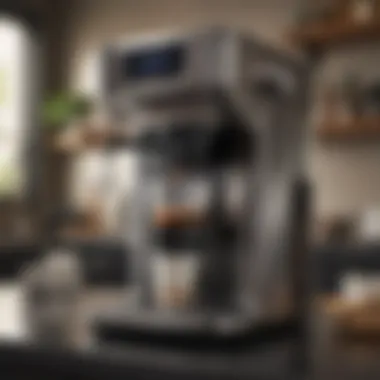Washing Your Coffee Maker with Vinegar: An Essential Guide


Intro
Maintaining the optimal performance of your coffee maker is essential for enjoying a great cup of coffee. When machines are not properly cleaned, mineral build-up can affect coffee quality and make appliances less efficient. Using vinegar as a cleaning agent is an effective, natural solution that not only cleans but also enhances the life of your coffee maker. This guide will lead you through the process of cleaning your coffee maker with vinegar, highlighting its benefits, and providing tips for ongoing maintenance.
The Importance of Regular Cleaning
Coffee makers routinely gather deposits from minerals found in water. These deposits can build up over time, leading to potential malfunctions and diminished taste in your beverages. Cleaning your coffee maker with vinegar serves as a cost-effective and eco-friendly way to address this issue while prolonging the lifespan of the machine.
Benefits of Using Vinegar
Vinegar contains acetic acid which does a good job at breaking down mineral scale. Some important benefits include:
- Natural Cleaner: Vinegar is non-toxic, making it safe for both you and the environment.
- Cost-Effective: Compared to specialized cleaning products, vinegar is inexpensive and readily available.
- Simple Process: Cleaning with vinegar is straightforward and does not require specialized tools.
Step-by-Step Cleaning Procedure
Here is a methodical approach to cleaning your coffee maker with vinegar:
- Prepare Your Coffee Maker: Unplug the machine and empty any leftover coffee and water from the reservoir.
- Mix Vinegar and Water: Combine equal parts of water and white vinegar. Generally, a mixture of one cup each is sufficient for most coffee makers.
- Fill the Water Reservoir: Pour the vinegar solution into the water chamber of the coffee maker.
- Run the Brew Cycle: Turn the coffee maker on and run a full brewing cycle.
- Rinse: After the cycle completes, discard the solution and rinse the water reservoir, followed by filling it with clean water.
- Final Brew Cycle: Run another cycle with just water to clear out any residual vinegar.
The Aftermath: Effects of Mineral Build-Up
When left uncleaned, mineral deposits can create a barrier, causing machines to work harder and potentially malfunction. Coffee extracted from a dirty machine may taste bitter or stale due to residue. Regular cleaning mitigates these effects, ensuring rich, fresh flavor in every cup.
Long-Term Maintenance Tips
Maintaining a clean coffee maker is not just about occasional deep cleaning. Following these tips can help sustain performance:
- Routine Cleaning: Aim to clean your coffee maker every one to three months depending on usage.
- Water Quality: Use filtered water to minimize mineral build-up.
- Storage: When not in use for extended periods, clean and store the machine properly to avoid accruing dust or residues.
"Regular maintenance can significantly improve your coffee experience and ensure you continue to enjoy fresh flavors."
By employing vinegar for your coffee maker cleaning, you are choosing an effective, environmentally friendly solution. This approach paves the way for a fresher, healthier coffee experience, demonstrating respect not only for your appliance but also for your palate.
Preamble to Coffee Maker Maintenance
Maintaining a coffee maker is crucial not just for its longevity, but also for the quality of the coffee it produces. Regular cleaning enhances both functionality and flavor. A neglected coffee machine can harbor mineral deposits and old coffee oils, which may lead to subpar brews and potentially harmful bacteria. Emphasizing maintenance as a fundamental practice can save money and improve the overall coffee experience.
Understanding the Importance of Cleaning
The cleaning of a coffee maker should not be an afterthought. Over time, mineral deposits accumulate from the water used to brew coffee, particularly in areas with hard water. These deposits can obstruct the brewing process and affect the taste of the coffee. Regular cleaning helps to ensure that each cup of coffee remains as flavorful as the first.
In addition, old coffee grounds can create off-putting flavors. This buildup is a breeding ground for bacteria, which can affect health. Noting the importance of cleaning helps to guard against these issues and promotes better health through proper appliance care. A clean coffee maker not only enhances the taste but also extends the lifespan of the machine.
The Role of Vinegar in Cleaning


Vinegar is a powerful, natural cleaning agent. Its acidity helps to dissolve mineral deposits and oil residue that accumulate in the coffee maker. Using vinegar offers an economical and eco-friendly solution to effectively clean the coffee machine without harsh chemicals. The process is simple. The vinegar solution breaks down buildup in critical components such as the water reservoir and tube.
While using vinegar might produce a strong odor initially, this dissipates quickly and leaves the coffee maker clean and refreshed. This natural substance helps to maintain the machine's functionality, ensuring that coffee always tastes its best. Furthermore, incorporating vinegar into your cleaning routine aligns with a growing trend towards sustainability in kitchen practices.
How Does Vinegar Work as a Cleaner?
Understanding how vinegar functions as a cleaning agent is critical for effectively maintaining your coffee maker. The unique properties of vinegar, particularly its acidity, play a major role in breaking down mineral build-up and other residues found in appliances. This section delves into the chemical makeup of vinegar and how it combats mineral deposits, providing a clear viewpoint on its cleaning capabilities.
Chemical Composition of Vinegar
Vinegar primarily consists of acetic acid, typically ranging from 4% to 8% in household varieties. This acidity is the key to its effectiveness as a cleaner. When vinegar is combined with water, it creates a solution that not only cleans but also disinfects. The acidic nature of vinegar allows it to react with alkaline substances, helping to dissolve grime and scale.
In addition to acetic acid, vinegar contains trace quantities of various other compounds, including vitamins and minerals. However, its main function derives from the acetic acid, which interacts with calcium carbonate found in mineral deposits. As these deposits dissolve, the cleaning surfaces of your coffee maker remain clear, which contributes to a better brew.
Effectiveness Against Mineral Deposits
Mineral deposits often accumulate in coffee makers due to hard water. These minerals, mainly calcium and magnesium, can affect both the taste of your coffee and the functionality of your machine. Vinegar’s acidity provides an efficient solution to this common issue. When undiluted vinegar is heated, it enhances its effectiveness in loosening and eliminating mineral deposits through a process called chelation. This essentially means that the acetic acid in vinegar binds with the minerals, making it easier for them to be rinsed away.
"Vinegar is not just an edible product; it serves as a versatile and natural cleaning agent that can prolong the life of your coffee maker."
To tackle mineral build-up, it is advisable to run a cleaning cycle with vinegar on a regular basis. This can lead to cleaner taste in your coffee, and contribute to the longevity of the appliance. Regular cleaning using vinegar can decrease the frequency of heavy descaling, saving time and effort in the long run.
In summary, vinegar is an effective cleaner due to its chemical properties, especially its acetic acid. This characteristic allows it to dissolve mineral deposits efficiently. Emphasizing this natural cleaning method can lead to improved performance and extended lifespan of your coffee maker.
Preparing Your Coffee Maker for Cleaning
Cleaning your coffee maker is an important task that many homeowners overlook. Before any cleaning can occur, it is crucial to prepare your coffee maker properly. This step ensures that the cleaning process will be effective and that all parts of the machine are accessible. Proper preparation enhances the overall cleaning outcome while minimizing the potential for any damage to components. Understanding how to prepare your coffee maker sets a solid foundation for maintaining its performance and longevity.
Gathering Necessary Supplies
Vinegar
Vinegar is a central ingredient when cleaning your coffee maker. Its acetic acid content provides effective natural cleaning properties. Vinegar is a go-to choice because it works well against mineral deposits and coffee stains. One unique feature of vinegar is that it is non-toxic, making it a safe option for household cleaning. However, its strong smell may be unpleasant for some users, although it dissipates after use. Choosing vinegar ensures a thorough and safe cleaning experience.
Water
Water is equally important in the cleaning process. It acts as a diluent for vinegar, making the solution less potent and easier to manage. One key characteristic of water is its ability to flush away residues and deposits that accumulate inside the coffee maker. Additionally, using fresh, clean water can help enhance the cleaning effects of vinegar. Be mindful that tap water may contain impurities, which could affect the taste of your coffee. Therefore, using filtered water can be an advantageous choice for better results.
Measuring Cup
A measuring cup plays a vital role in achieving the correct vinegar-to-water ratio. Precision is important for the effectiveness of your cleaning solution. A key benefit of using a measuring cup is that it helps prevent overflowing or wasting materials. Measuring cups often come with clear markings for accurate measurement, which is beneficial. Some people may think they can estimate the amounts, but this may lead to inconsistency in cleaning strength. Thus, utilizing a measuring cup ensures that you follow the recommended ratios accurately.
Cloth or Sponge
A cloth or sponge is essential for wiping down the exterior of the coffee maker and its detachable parts after cleaning. It helps remove any residues left behind and contributes to a polished appearance. The key feature of a cloth or sponge is their absorbency; they can efficiently soak up any remaining liquid or cleaning solution. While disposable cloths are convenient, using a reusable sponge can be more sustainable. However, ensure it is clean to avoid transferring dirt back onto your appliance.
Detaching Components


Before starting the cleaning process, it is necessary to detach any removable components from the coffee maker. This may include the carafe, filter basket, and water reservoir. Detaching components gives access to parts that need cleaning, and it allows for a more thorough job. Some components might be dishwasher-safe, which adds convenience. Take care to follow the manufacturer's guidelines to avoid unintentional damage, ensuring that all parts are properly cleaned without complications.
Step-by-Step Cleaning Process
Maintaining a clean coffee maker is essential for preserving the taste and quality of your coffee. The step-by-step cleaning process outlined here provides clear guidance to effectively remove mineral build-up and deliver a better brew. Each step is designed to enhance the longevity of the coffee machine and improve overall functionality. Following these simple steps ensures that the coffee maker operates efficiently, producing delicious coffee each time you brew.
Mixing the Cleaning Solution
Creating the right cleaning solution is crucial for the effectiveness of the cleaning process. Proper ratios between vinegar and water yield the best results in removing stubborn stains and mineral deposits.
Recommended Ratios of Vinegar to Water
For optimal results, a common ratio is one part vinegar to two parts water. This mixture balances the acidity of vinegar with the needed mildness of water. The vinegar’s acidity effectively dissolves calcium deposits and other residues. This ratio works well because it is neither too harsh to damage any components nor too weak to be ineffective. Moreover, it is simple to remember and measure, making it a beneficial choice for regular maintenance. The unique feature of this ratio is its adaptability; you can adjust it slightly based on how heavily soiled the coffee maker is. A stronger mixture might be required for more frequent build-up.
Alternative Solutions
While vinegar is excellent for cleaning, other solutions are also available. Baking soda and lemon juice are common alternatives. Baking soda is effective at neutralizing odors, while lemon juice can provide a pleasant scent and adds additional cleaning power due to its citric acid content. These alternatives can be appealing for those who prefer non-vinegar options. However, while they work well for general cleaning, they might not be as effective in breaking down heavy mineral deposits as vinegar. Therefore, regular use of vinegar should still be prioritized for thorough cleaning sessions.
Running the Cleaning Cycle
After preparing the solution, the next step is to run the cleaning cycle. This involves pouring the cleaning mixture into the reservoir and starting a brewing cycle without any coffee grounds. This stage is essential as it ensures that the entire internal apparatus is exposed to the cleaning solution, allowing it to do its job effectively. It’s important to monitor the process closely and allow it to run fully to ensure maximum cleanliness.
Rinsing with Fresh Water
Once the cleaning cycle is complete, rinsing the coffee maker with fresh water is vital. This step removes any lingering vinegar or cleaning solution residues. Fill the reservoir with fresh water and run another brewing cycle. It may be necessary to repeat this process a couple of times. Ensuring that no residual cleaning agents remain will leave you with fresh coffee untainted by cleaning chemicals, preserving the rich taste you expect from your machine.
Post-Cleaning Maintenance
Maintaining your coffee maker after a cleaning session is crucial for ensuring its longevity and optimal performance. Post-cleaning maintenance focuses on assessing any wear and tear, and implementing strategies to uphold both functionality and hygiene of the appliance. This phase helps in preventing future build-up of mineral deposits and ensures that the coffee tastes fresh and clean, contributing to the overall quality of your brew.
Inspecting Components
Once you have completed the inital cleaning process with vinegar, it is essential to inspect all components of the coffee maker. This includes the water reservoir, brew basket, and carafe.
- Check for Residue: Look for any remaining vinegar or debris left behind after rinsing. It is important to ensure that no cleaning solution affects subsequent coffee brews.
- Look for Wear: Assess parts like the rubber seals and filters for signs of wear. Damaged components can compromise the efficiency of your machine,
- Replace as Necessary: If anything seems out of place, consider replacing those components. This proactive approach is vital in maintaining appliance performance.
This thorough inspection not only enhances the lifespan of your coffee maker but also guarantees safe and flavorful coffee.
Best Practices for Regular Cleaning
Adhering to best practices for regular cleaning goes hand in hand with post-cleaning maintenance. Here are some guidelines to help you establish an effective cleaning regimen:
- Frequency: Clean the coffee maker at least once a month or more often if you use it daily. Regular cleaning prevents mineral buildup and other impurities that affect coffee flavor.
- Use of Vinegar: Continue utilizing vinegar for regular cleaning cycles, as it is an effective, natural cleaner.
- Wipe Down Exterior: Don’t forget to clean the exterior surfaces with a damp cloth. This simple maintenance step keeps the coffee maker looking good and prevents buildup of dust and grime.
- Deep Clean: Annually consider doing a deeper cleaning. This involves disassembling components for a thorough wash to eliminate any hidden residues.
- Monitor Performance: Pay attention to how your coffee maker dispenses coffee. Any irregularities could indicate that it needs immediate attention.
By incorporating these best practices into your routine, you ensure that your coffee maker remains in peak condition, maximizing your brewing experience.
"A well-maintained coffee maker is essential not just for good hygiene, but also for ensuring every cup of coffee tastes its best."


Regular post-cleaning checks and maintenance promote not only the efficiency of your machine but also enrich the experience of making coffee.
Potential Risks of Using Vinegar
Cleaning your coffee maker with vinegar can be an effective method to maintain performance and taste. However, it is crucial to consider the potential risks associated with this practice. Understanding these risks will help you make informed decisions about the cleaning methods that best suit your coffee maker type.
Effects on Specific Coffee Maker Types
Different coffee makers have various materials and components that may react differently to vinegar. For instance, many modern machines have plastic parts that can become damaged when exposed to acidic cleaners like vinegar over time.
- Single-Serve Machines: These often feature delicate seals and components. Vinegar could corrode or damage them, leading to leaks or malfunctions.
- High-End Espresso Machines: These may have aluminum or specific alloys in their construction. Vinegar can lead to discoloration or etching, which could impact functionality.
- Glass Carafes: While vinegar poses minimal risks to glass, it can still affect the aesthetics of the carafe if not rinsed thoroughly.
Each type of coffee maker may need a different maintenance routine. Frequently refer to the manufacturer's guidelines to ensure compatibility with vinegar cleaning.
Preventing Damage to Components
To limit risks, proactive steps should be taken whenever you choose vinegar as a cleaning agent. Here are some strategies:
- Dilute the Vinegar: Always mix vinegar with water. A common ratio is one part vinegar to two parts water. This dilution reduces acidity and minimizes the chance for damage.
- Limit Frequency: Use vinegar for deep cleaning sparingly. Depending on usage, a quarterly deep cleaning may be sufficient.
- Follow Up with Rinsing: After running vinegar through your coffee maker, it is vital to flush it with fresh water multiple times. This will remove any residual vinegar that could affect future brews.
- Inspect Components Regularly: After cleaning, check for any signs of wear or damage to important parts. This includes seals, valves, and heating elements, which should be maintained carefully.
By understanding the unique risks and taking precautionary measures, you can effectively use vinegar for cleaning without jeopardizing your coffee maker's integrity. Remember that each cleaning agent has its pros and cons, and sometimes less acidic solutions might be more appropriate for certain machines.
Alternative Cleaning Methods
Exploring alternatives to vinegar for cleaning coffee makers is valuable. While vinegar is effective, there are different methods that can also yield positive results. Understanding these alternatives provides options for individuals with specific preferences or those who may have concerns about using vinegar. By evaluating these cleaning methods, one can decide what best suits their needs.
Commercial Cleaning Solutions
Several commercial cleaning solutions exist specifically designed for cleaning coffee makers. These products often contain formulations that target specific stains and deposits without harsh chemicals. When selecting a commercial cleaner, consider the following:
- Effectiveness: Many solutions are optimized for removing mineral buildup.
- Safety: Ensure that the product is safe for your specific coffee maker type.
- Ease of Use: A straightforward application process can save time.
Common brands include products like Urnex and Dezcal. Users typically find that these products can clean efficiently, often reported to leave machines working as good as new. Always follow the manufacturer's instructions for the best results. However, it is crucial to ensure compatibility with your machine to avoid any unwanted damage.
Using Baking Soda
Baking soda emerges as a natural cleaning agent that can be beneficial for coffee makers, particularly due to its gentle abrasive properties. It can effectively tackle odors and stains, which often accumulate with repeated use. Here’s how to effectively use baking soda to clean your coffee maker:
- Mixing Solution: Combine one tablespoon of baking soda with water to create a cleaning solution.
- Application Process: Pour this mixture into the water reservoir and run a brewing cycle. After one cycle, it is advisable to run additional cycles with clean water to eliminate any residue.
Benefits of using baking soda include its affordable price and non-toxic nature, making it a suitable option for many households. For those interested in a more eco-friendly approach to cleaning, baking soda presents a compelling choice.
"Natural cleaning methods can often provide equally effective results without the use of harsh chemicals."
Ultimately, considering alternative cleaning methods ensures your coffee maker remains in optimal condition. Whether by selecting commercial solutions or employing natural cleaners like baking soda, each method has unique advantages suitable for different needs.
The End
Cleaning your coffee maker with vinegar is an essential practice for ensuring not only the longevity of your machine but also the quality of the coffee you brew. Regular maintenance directly contributes to the optimal performance of your coffee maker, which in turn enhances the overall coffee experience at home. This article has explored the multiple facets involved in cleaning with vinegar, from understanding its efficacy against mineral build-up to the straightforward steps required for a thorough clean.
Recap of Cleaning Benefits
Using vinegar as a cleaning agent provides several benefits that should not be overlooked. First, vinegar is a cost-effective solution that eliminates the need for expensive commercial cleaners. It contains acetic acid which effectively dissolves mineral deposits due to hard water and other impurities found in coffee. By regularly cleaning your machine with vinegar, you can prevent unwanted flavors and odors that develop over time. This results in a more enjoyable drinking experience and ensures that each cup of coffee tastes how it should: fresh and rich. Additionally, vinegar is non-toxic and environmentally friendly, making it a safer choice for your kitchen compared to harsher chemical alternatives.















